The first few times I saw real anemones, they were elegantly tucked into bridal bouquets. With their slender stems and marshmallow-like blooms, anemones looked as fragile as they did elegant.
This must have been why I had this preconceived notion that anemones are one of those elusive flowers that only professional commercial growers can manage to pull off. Surely, they can’t be easy to grow in my backyard garden? And surely, you’d need a controlled environment such as a greenhouse in order to grow beautiful anemones!
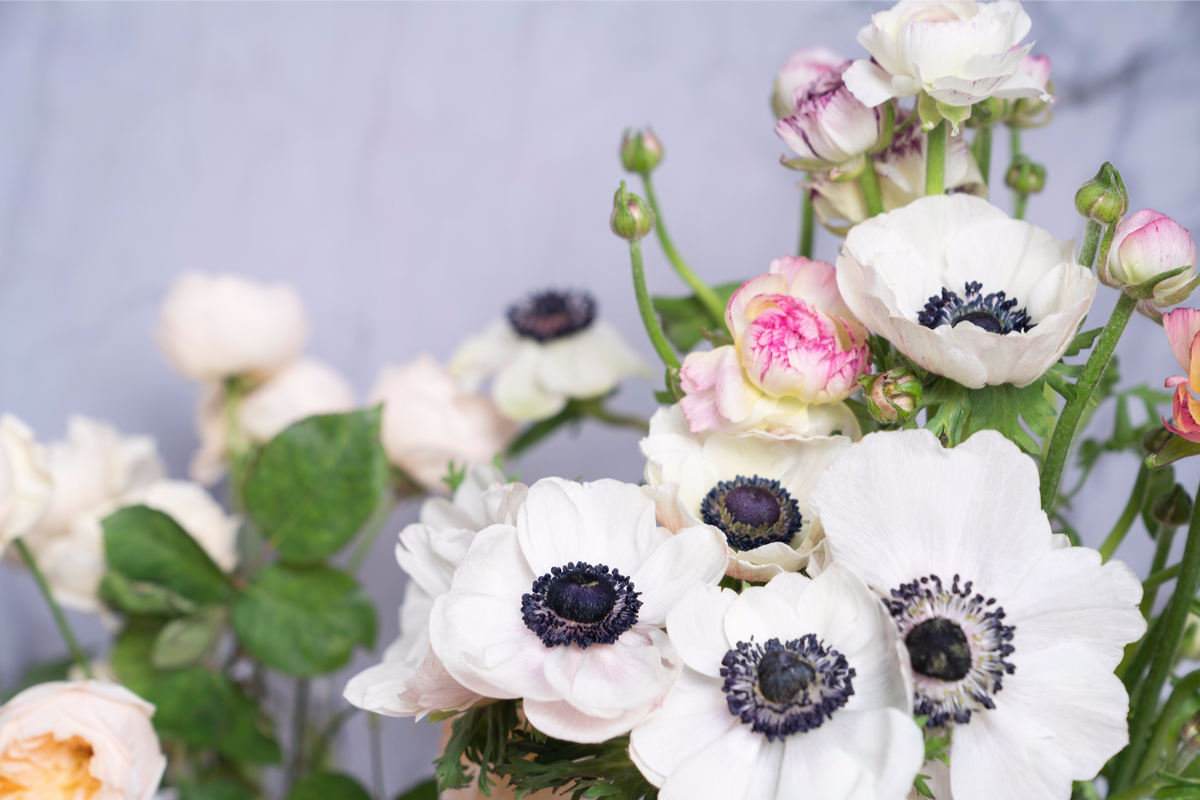
I luckily realized that I couldn’t have been further from the truth when I received a package of anemone corms as a present a couple of years later. Since it was an unexpected gift, I managed to get over my initial timidity, did a bit of research and planted the corms the following fall. Let’s just say I was hooked. Little did I know this would be the beginning of an obsession with the dainty anemone.
Here’s a short guide on how to grow anemones in your garden for an extra dash of spring and summer color.
What kind of anemones should I plant?
First, let me clarify that I’ll be talking about anemones that are usually grown in gardens, not the varieties that can still be found as wildflowers in parts of Southern Europe, Turkey and the Middle East.
Anemones are part of the Ranunculaceae family, together with buttercups, delphiniums and clematis. There are three types of anemones popular with gardeners: Anemone blanda, Anemone coronaria and Anemone hupehensis.
Let’s have a look at their main characteristics and see which one might be a good fit for your garden.
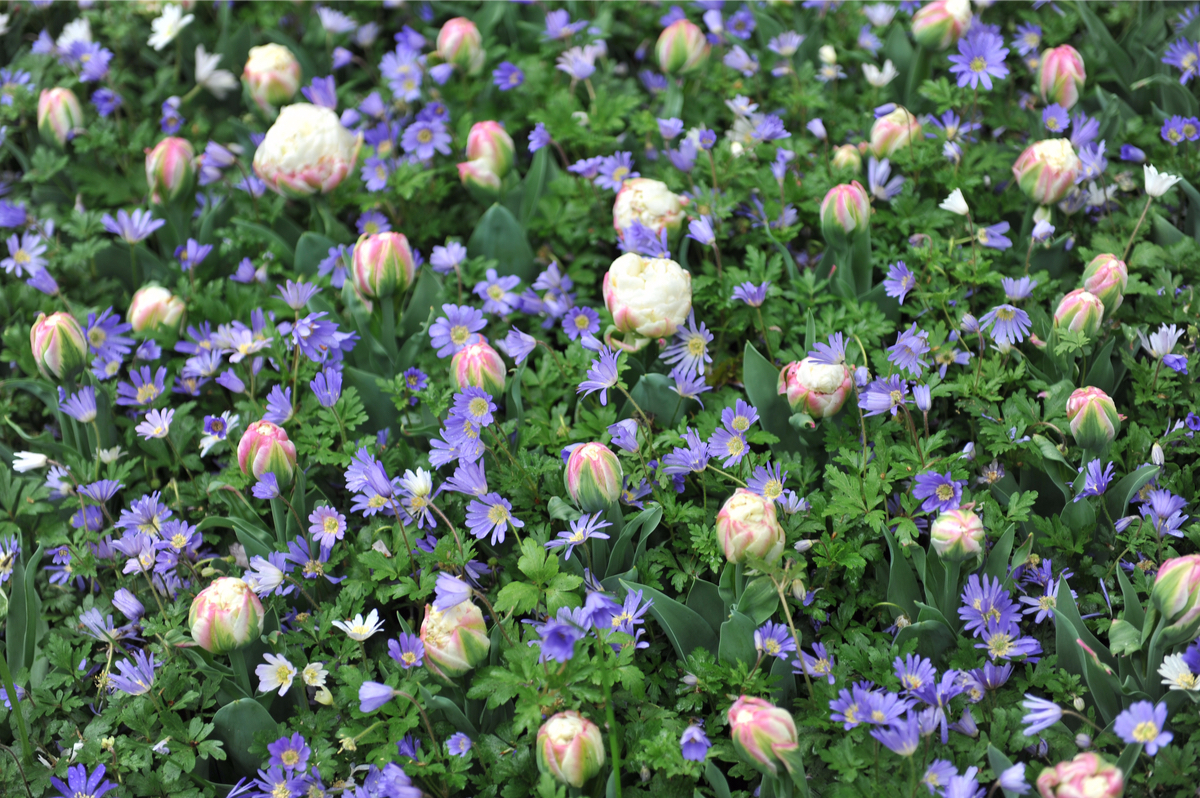
1. Anemone blanda
Anemone blanda (also known as Grecian windflowers or Balkan anemone) is native to Southeast Europe, Turkey, Syria and Lebanon.
This type of anemone grows from bulb-like structures called corms that you have to plant the previous fall. Because of their bloom time, Grecian windflowers look absolutely stunning in a spring garden planted in the company of daffodils, muscari, tulips, hyacinths and hellebores.
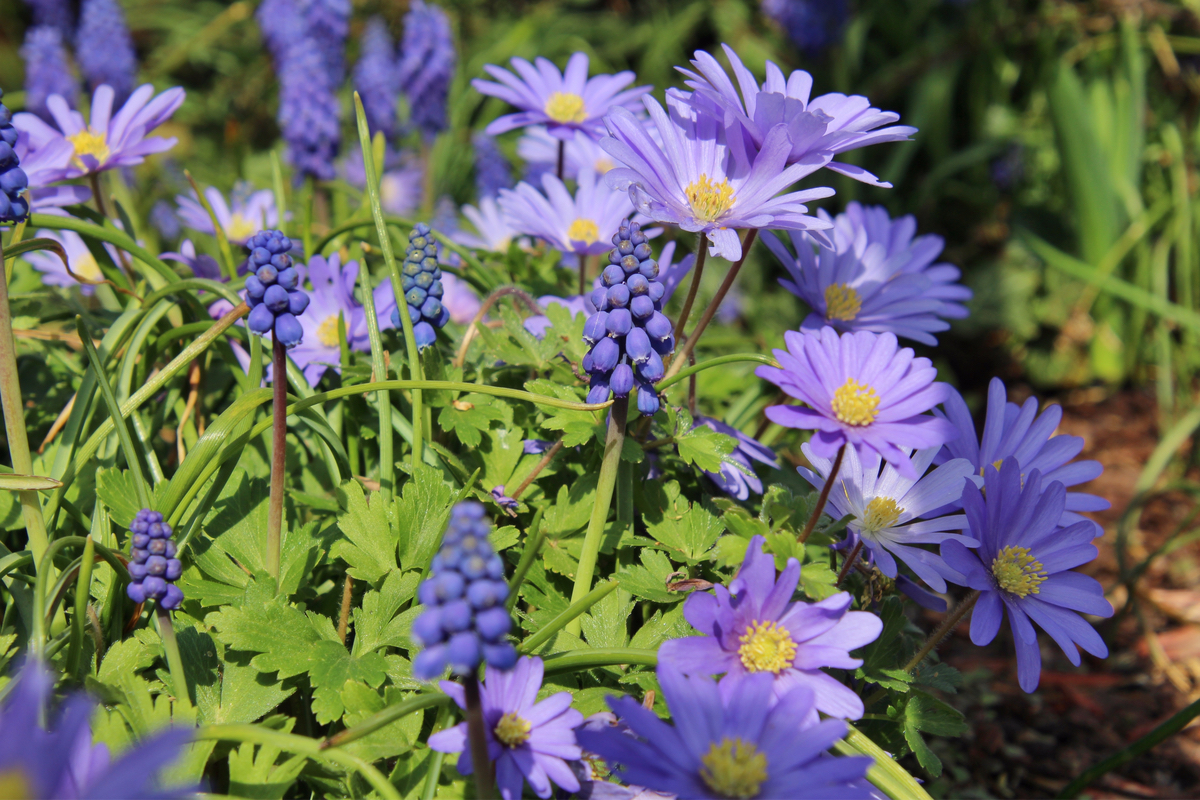
Anemone blanda is generally a compact low-growing plant (that can reach around 6-8 inches tall) with fern-like foliage and daisy-like blooms that come in different shades of red, white, pink and purple.
The flowers can stay in bloom for up to six weeks and you’ll often get more than one bloom per corm, depending on its size and on the energy stored in the tuber. The flowers go through a fascinating ritual of closing in the evening and opening up again in the morning when the sun starts to reach them.
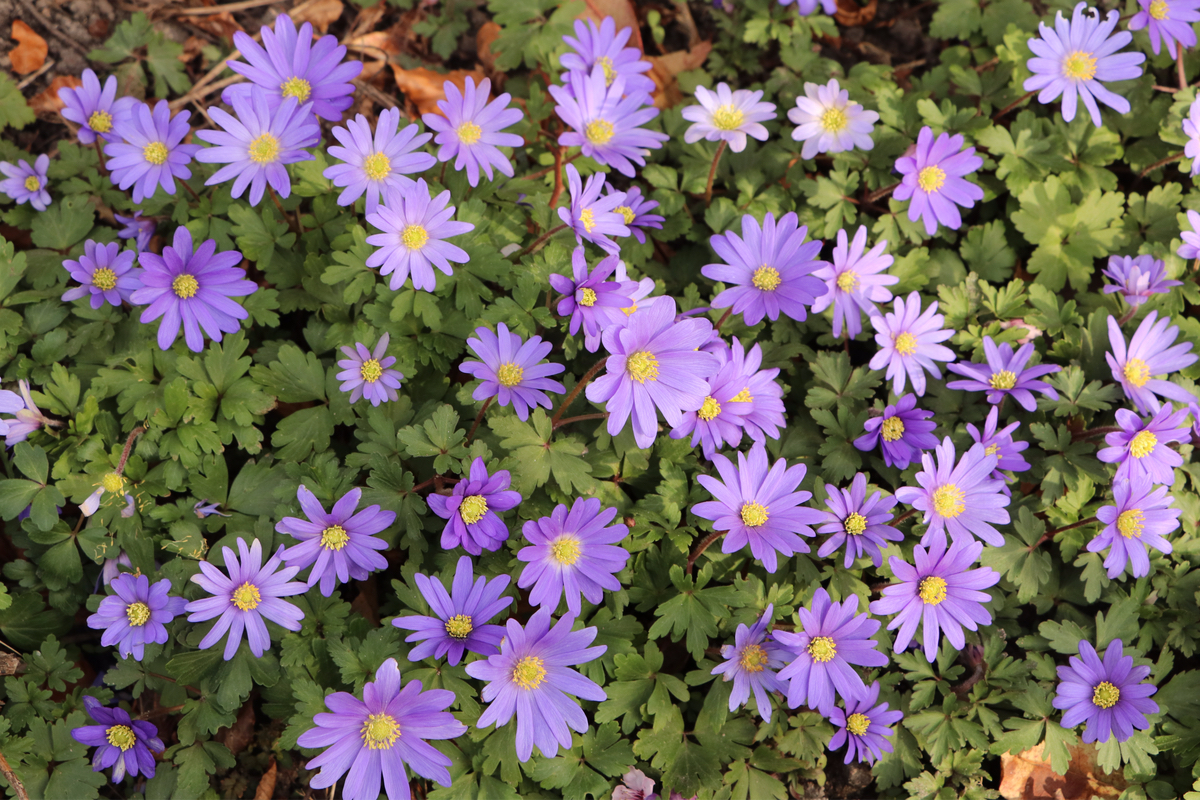
Anemone blanda loves being planted in full sun or part sun in well-draining soil. If you plant enough corms close together, you’ll get a mat-like ground cover that will stay green for another month or longer after the blooms are gone.
Popular varieties include:
Anemone blanda ‘Blue Shades’
Anemone blanda ‘White Splendor’
Anemone blanda ‘Ingramii’
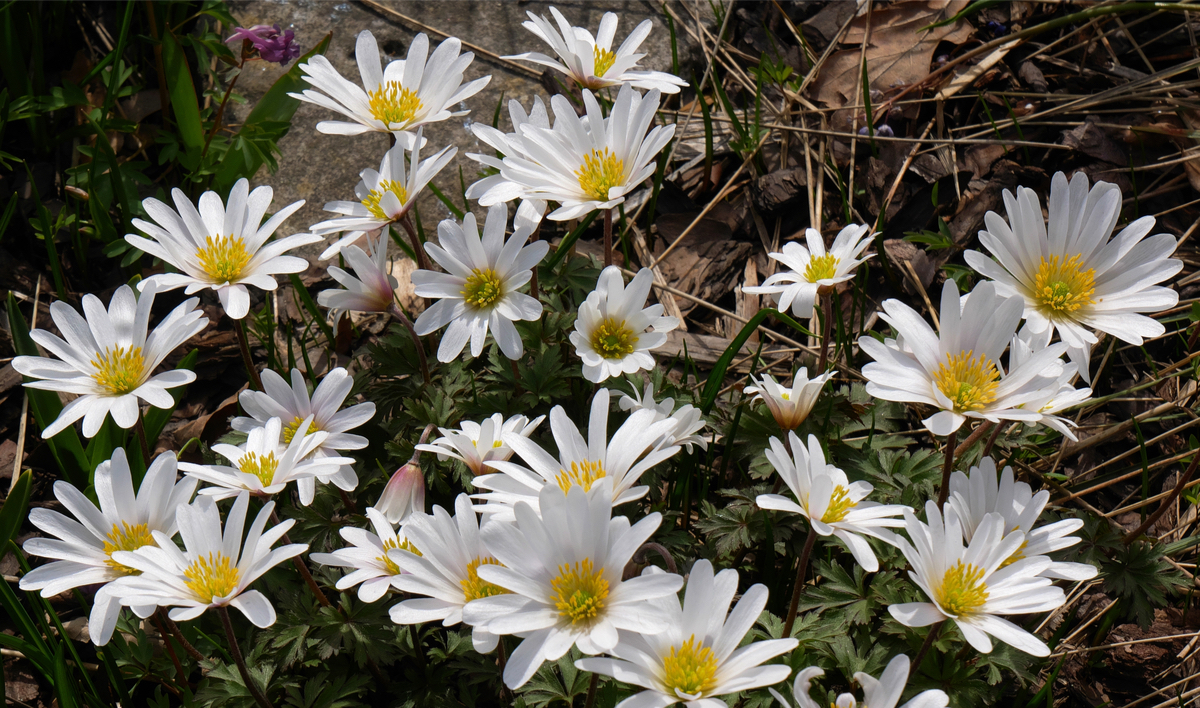
2. Anemone coronaria
Also called “poppy anemone”, this is the quintessential anemone that you’ll see in flower arrangements and bouquets. Another nickname for it is “florist’s anemone” due to its popularity with professional growers and its ease of growth in greenhouses and polytunnels. As a cut flower, the poppy anemone can last two to three weeks in water.
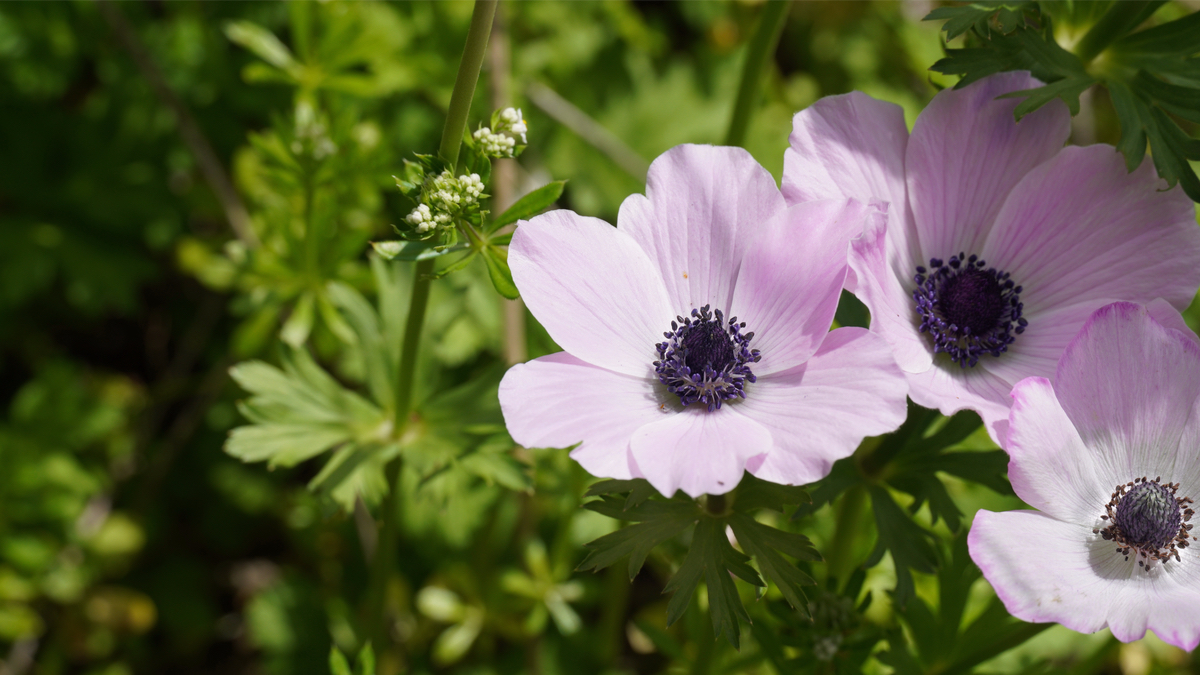
Poppy anemones can bloom from early spring to mid-summer, depending on your climate and when you’ve planted the corms. In warmer climates, the corms are planted in the fall for spring blooms. In climates with cold harsh winters, the corms should be planted in the spring for summer blooms. This makes them the perfect flower for a summer wedding bouquet.
Two very popular varieties of Anemone coronaria are the De Caen group and the St. Brigid group, two series of older hybrids with an abundance of cultivars to choose from.
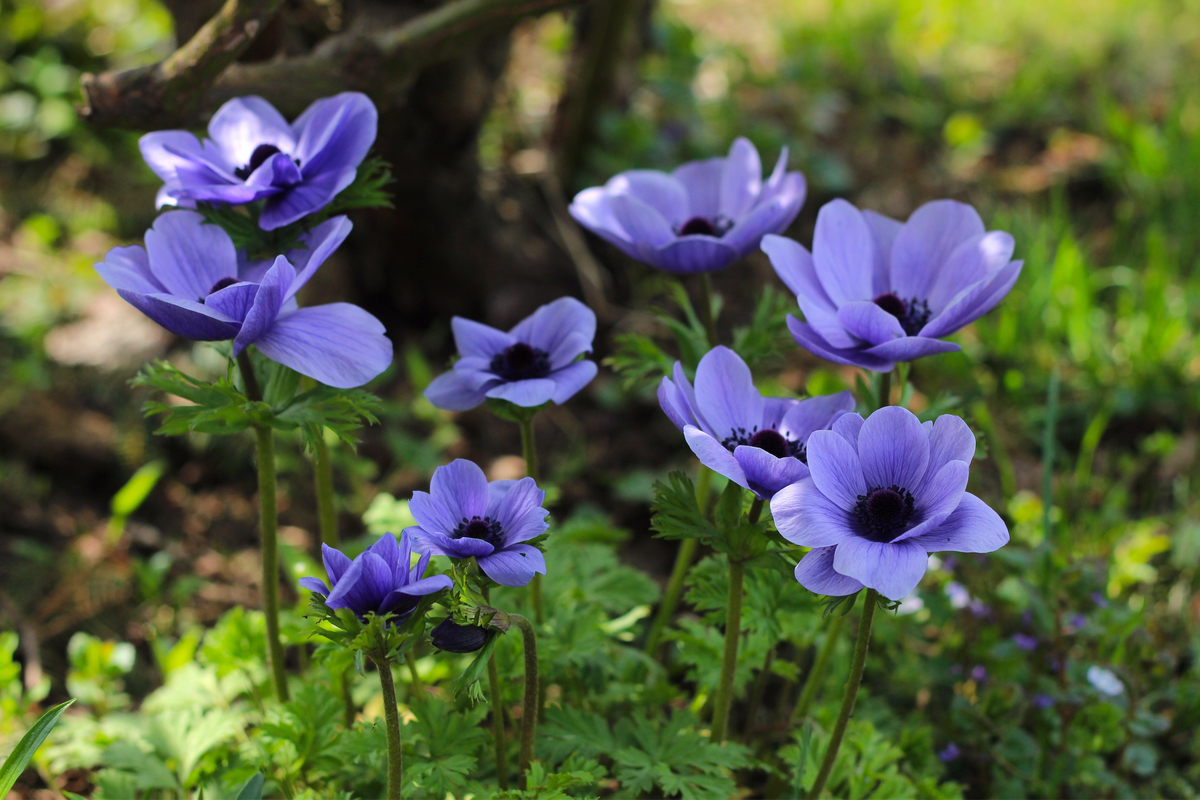
Unlike Anemone blanda, Anemone coronaria doesn’t like to compete with other plants and should be given its own dedicated space in the garden. That’s not to say that you need a buffer zone, but rather that you shouldn’t crowd it with other plants.
Anemone coronaria will produce one single flower per stem that can reach between eight and fifteen inches in height. The slenderness and sturdiness of the stem (with only basal leaves) and the elegance of the poppy-like bloom make it easy to work with in flower arrangements.
Popular varieties include:
Anemone coronaria ‘Jerusalem’
Anemone coronaria ‘Galilee Pastel’
Anemone coronaria ‘Mistral Bianco Centro Nero’
Anemone coronaria ‘Sylphide’
Anemone coronaria ‘Bicolor’
Anemone coronaria ‘Mona Lisa’
Anemone coronaria ‘Mr. Fokker’
Anemone coronaria ‘Holland’
Anemone coronaria ‘The Bride’
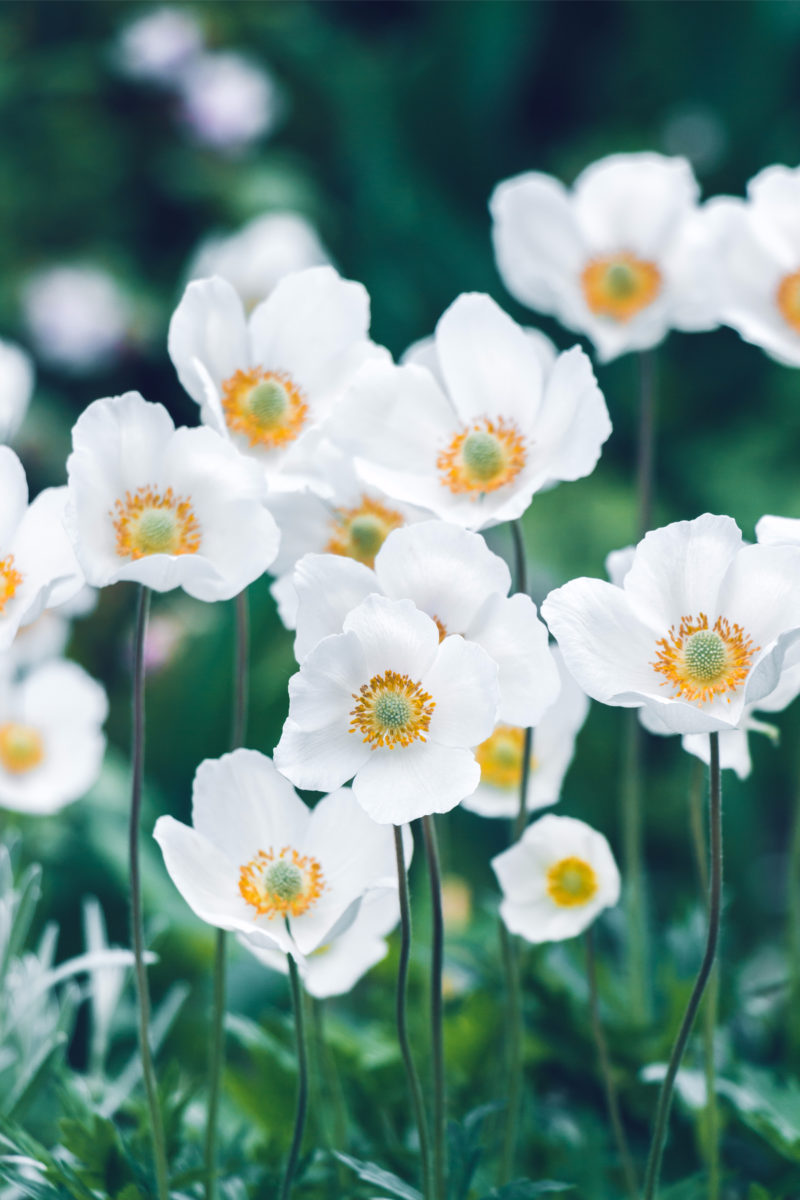
3. Japanese anemones
If you’re looking for an anemone that blooms in late summer or fall, you should choose Anemone hupehensis. Now also known as Eriocapitella hupehensis, it was formerly a member of the Anemone genus; but it has retained its gardening moniker of Japanese anemone. These flowers are native to China, but they’re called Japanese because that’s where most of our popular cultivars come from.
Japanese anemones are fall flowers that grow from a rhizome-like root structure to tall branching stems (between 25 and 45 inches) that end in white or pink blossoms. This makes them ideal for cut flowers, though they work better in more rustic and messy arrangements.
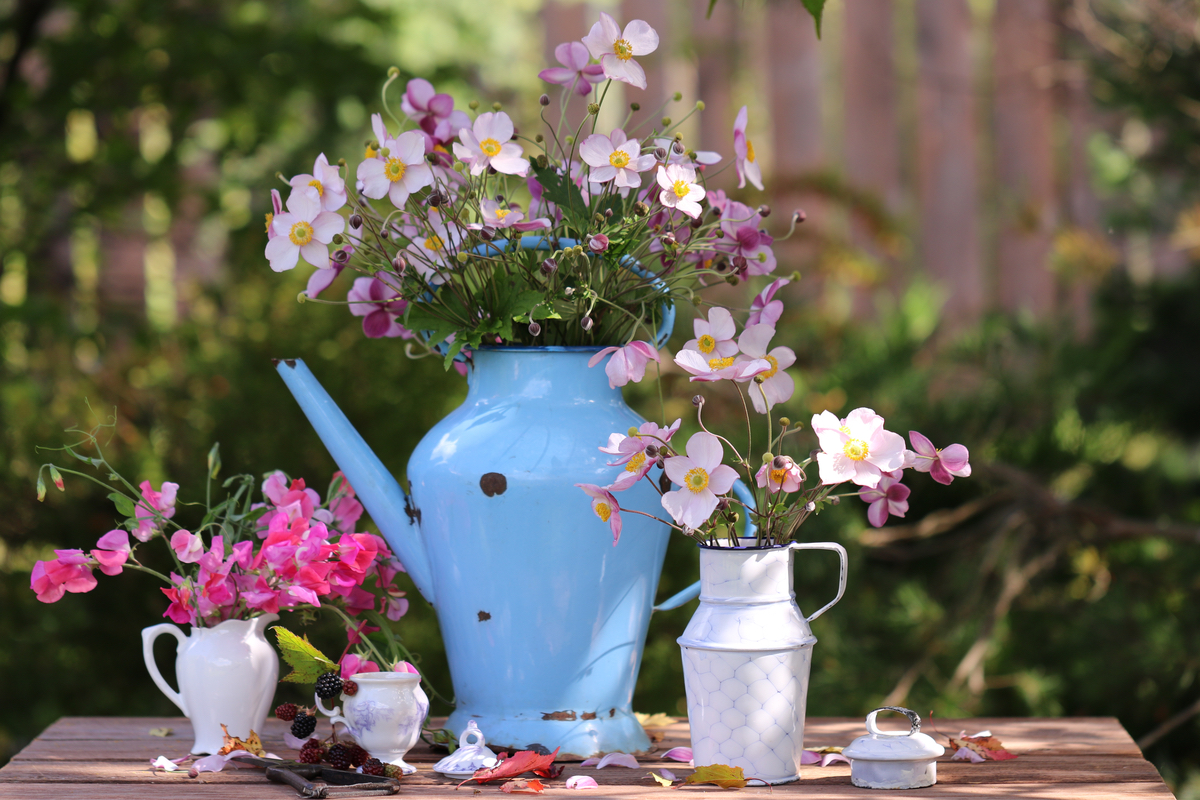
Japanese anemones do best in afternoon sun or dappled shade and fairly moist soil, although they can cope with drier soil as well. They can be planted in pots, shade gardens, under trees or in cottage gardens, but do be careful because they spread by sending underground runners.
In temperate and cold climates, the spread is easy to contain by dividing the flowers at the end of the season. Japanese anemones are a favorite with late-season pollinators.
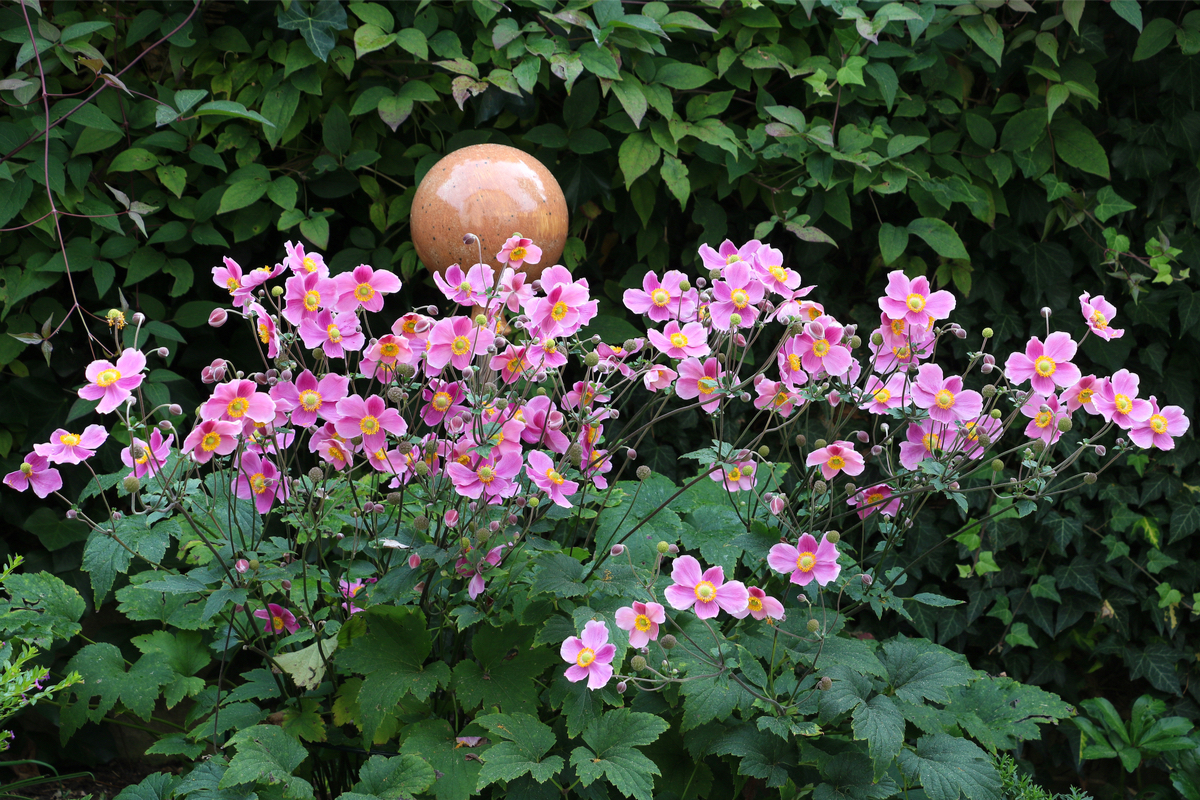
Popular varieties include:
Anemone hupehensis ‘Pamina’
Anemone hupehensis ‘Praecox’
Anemone hupehensis ‘September Charm’
Anemone hupehensis ‘Dreaming Swan’
Anemone hupehensis ‘Prinz Heinrich’
Anemone hupehensis ‘Honorine Jobert’
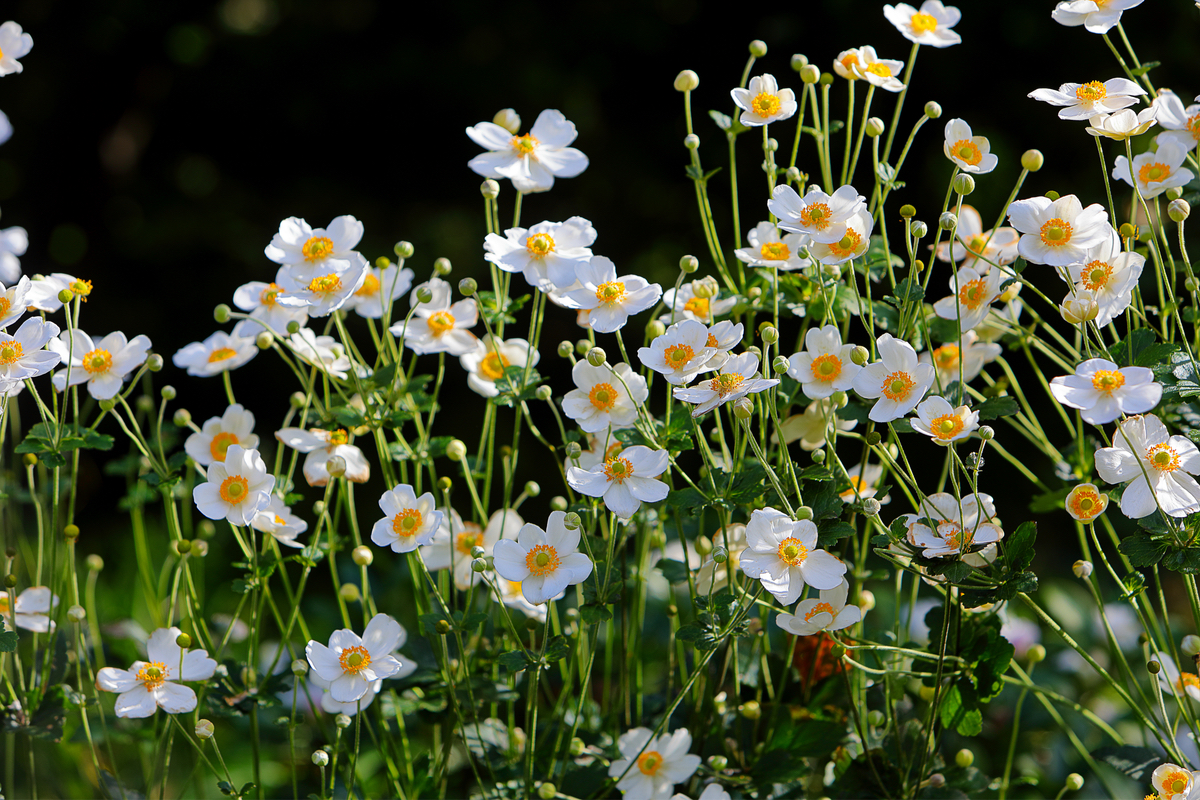
How do I plant anemones?
If you live in a milder climate, you can plant your anemones in the fall and let them overwinter in the ground. If your winters are long and cold, it’s better to plant the anemones in spring. A good rule of thumb is to plant anemones whenever you plant your other spring bulbs. So you’ll know that as soon as the garden is ready for daffodils and tulip bulbs, the anemones can go in too.
You might be a bit put off when you first unpack your delivery of anemone corms. I know I was skeptical. The dried shriveled chestnut look of the corms didn’t inspire much confidence, I’ll admit to that. But I’m glad I got over it.
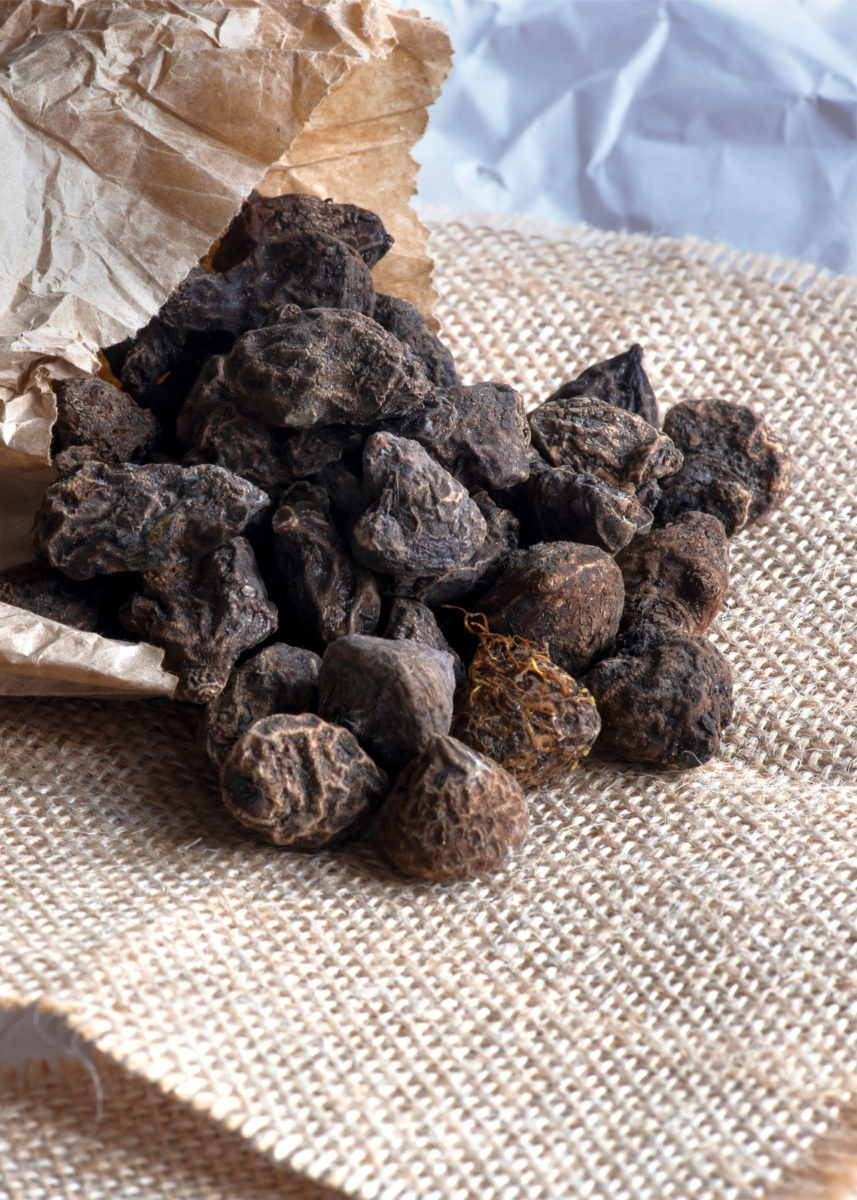
Before planting them, you should soak the bulbs in room-temperature water for about three to four hours in order to rehydrate them and give them a head start. Some packages say you should soak overnight, but I think that gets the corm too waterlogged.
In the meantime, prepare your soil by adding some fresh organic matter to fertilize it (see below). A good dose of compost, leaf mold, well-rotted manure, bone meal or balanced organic fertilizer should be enough if you’re planting in the fall. Always prepare the soil at least a few inches deeper than the depth you’re planning to plant at. The best place to grow bulbs is in loose, well-drained soil that’s rich in organic matter.
When you remove the corms from their soaking dish, you’ll notice that they’ve plumped up a bit due to absorbing the water. Unlike other spring bulbs, it’s hard to tell which side is the tip and which one is the root, especially for the Anemone coronaria variety. If you can’t figure it out, you should just bury the corms sideways and they’ll find their own way up.
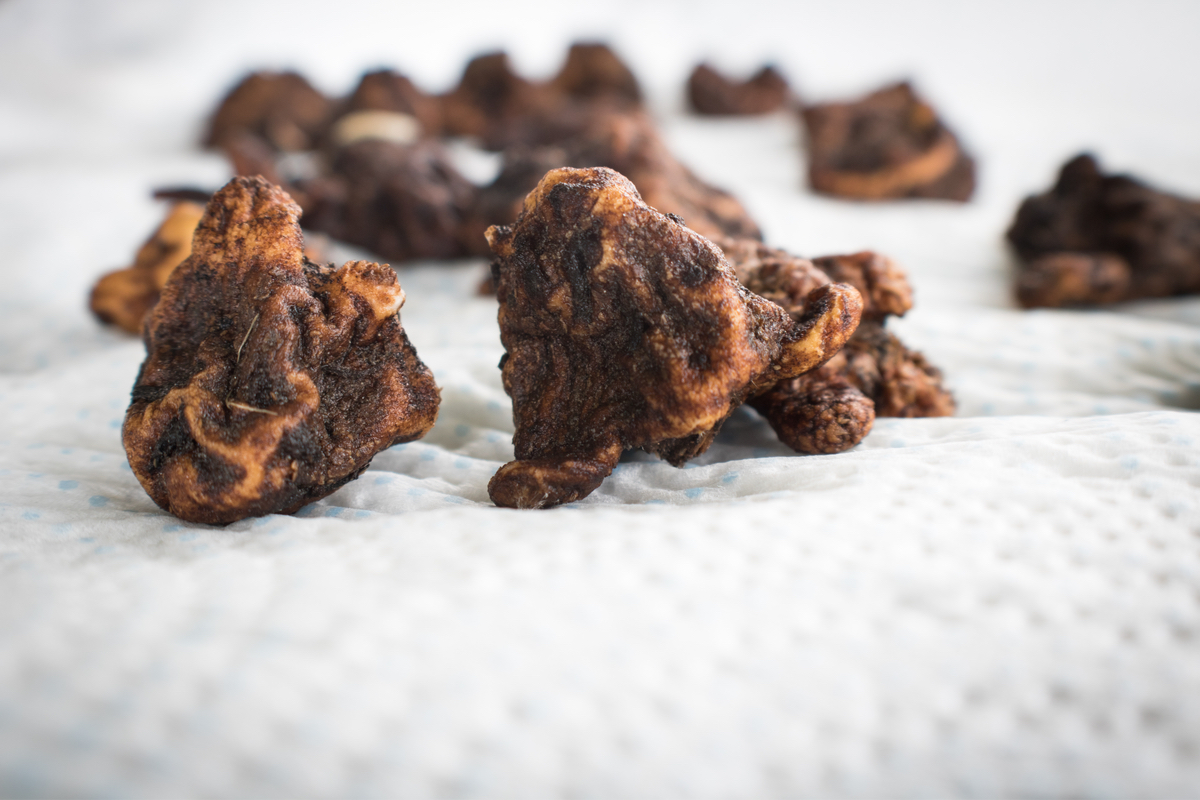
Plant Anemone blanda about two inches deep and three inches apart. If you’re planting Anemone coronaria, place them about three inches deep and four inches apart (measured from the center of the bulb). As a general rule, you want the depth of the hole to be about three times the size of the bulb.
After planting your bulbs, keep the area well-watered if you’re not getting any rain. You don’t have to soak the soil, but you should water deep enough for the moisture to reach the corms and encourage the start of root growth.
What kind of soil do anemones like?
Anemone blanda and coronaria like rich well-draining soil, while the Japanese variety can also handle soil that’s a bit more sandy. Before planting the corms, you should amend the soil to improve drainage. You can either use compost, leaf mold or composted bark (more on that later).
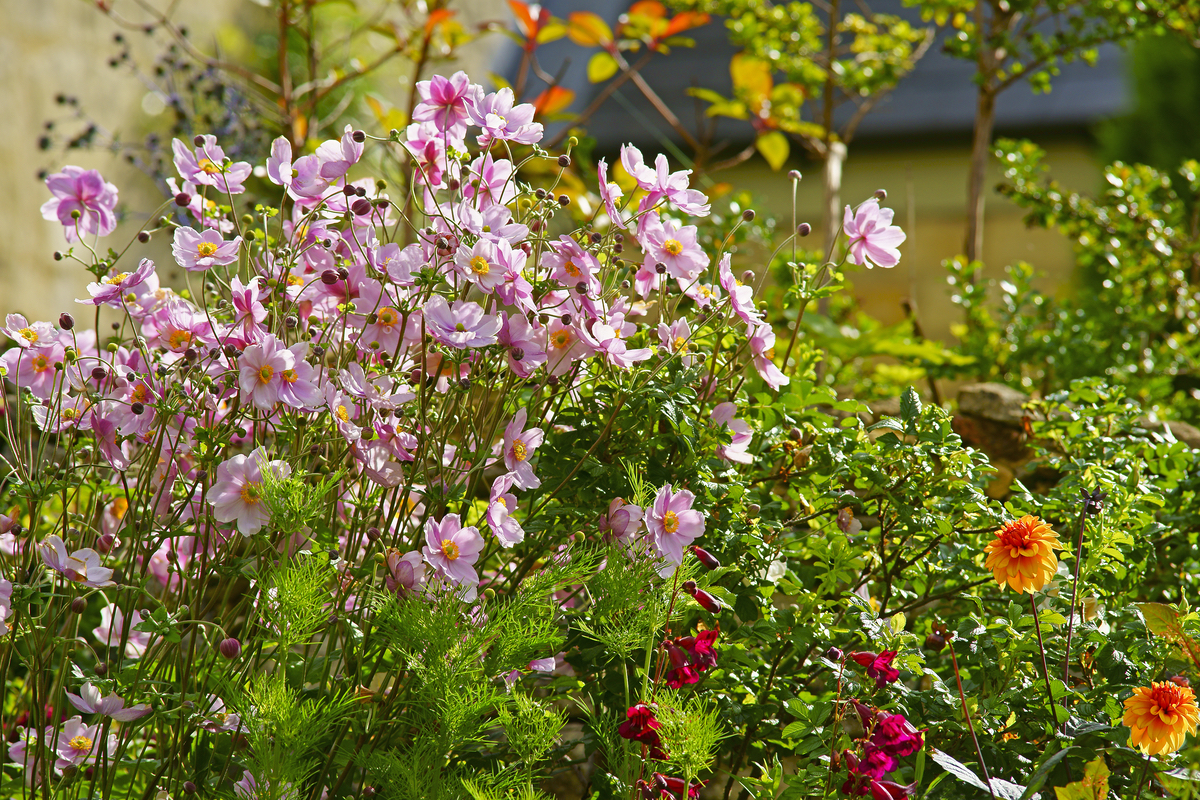
If you’re planting anemones in containers, make sure the pots have enough drainage holes. Anemone corms can’t be sitting in waterlogged soil for too long as they will begin to rot.
Anemones may not be too fussy about the soil, but depending on what variety you have, you may need to tweak a few factors to ensure that your plant has enough sunlight for a full rich bloom.
You can plant the spring-blooming anemones in partial shade or morning sun, the summer-blooming ones in full sun or partial sun and the fall-blooming anemones in full sun with afternoon shade.
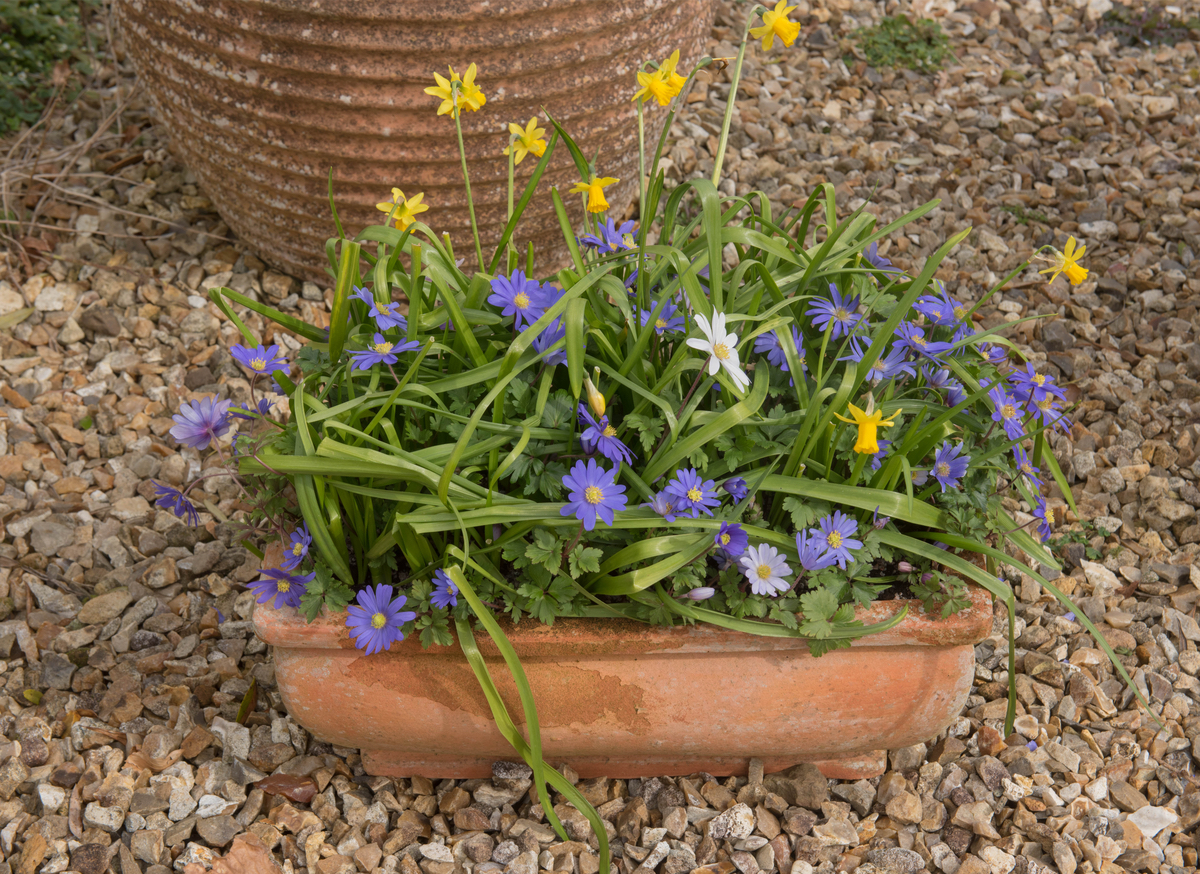
If you’re gardening in areas with intense sunshine, then plant your anemones in a partly sunny location that gets some afternoon shade. In general, the cooler the climate, the more sun this plant needs. The hotter the climate, the more part-shade it needs.
Space the smaller species about two inches apart and the taller anemones about ten inches apart, depending on how compact and cohesive you want your flower bed to look.
Should I water my garden anemones?
The answer is to always water if you’re gardening in a dry (or temporarily dry) climate.
Anemones are native to drier climates, so they will survive through short periods of drought. But if your garden is going through a prolonged dry spell, then you should water your anemones.
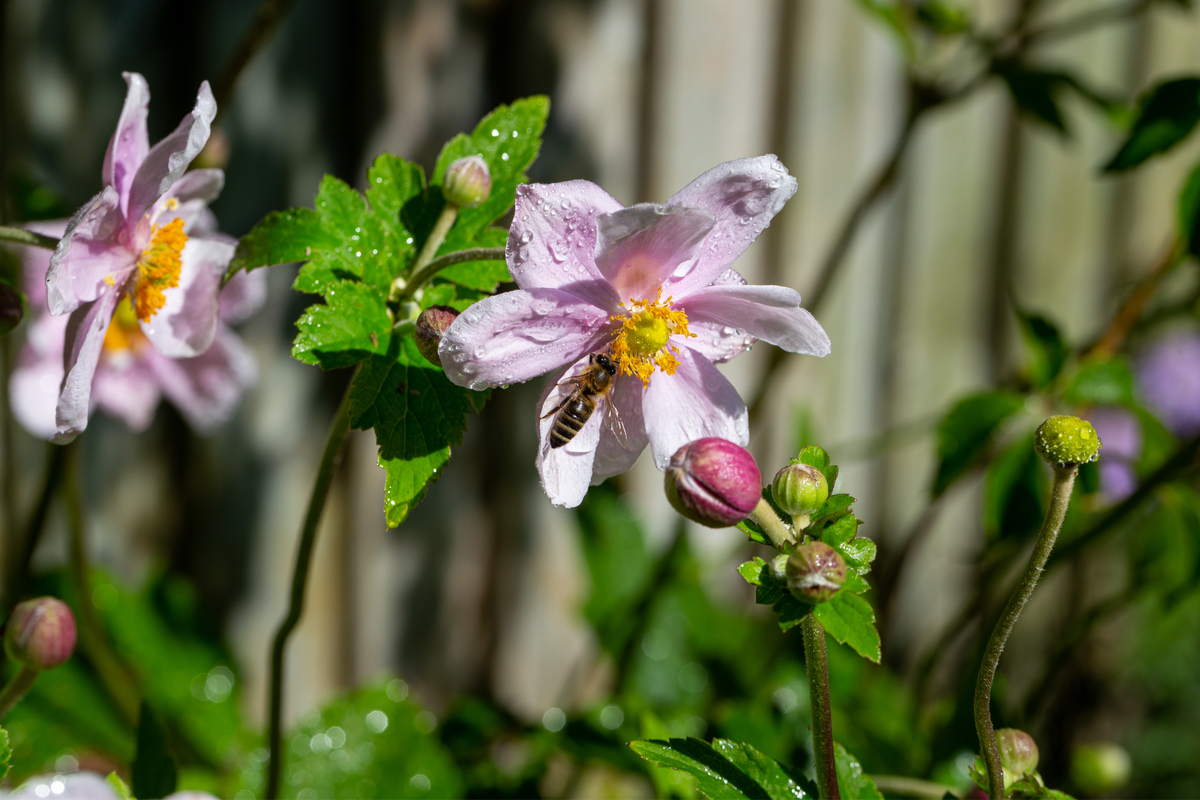
The one scenario in which you should water more often if it doesn’t rain is if you’re trying to get the bulbs established in spring. If, once you’ve planted the corms, there isn’t enough rain, you should make sure the soil around the planting site remains moist but isn’t soaking wet. Usually, this isn’t a concern with corms that have been planted in the fall.
Should I fertilize my anemones?
Anemones are not heavy feeders, and like most plants grown from bulbs, tubers or corms, most of the energy needed for a healthy plant is stored in the bulb throughout the previous growing season. So good bulb management (more on that later) is essential to getting a good crop.
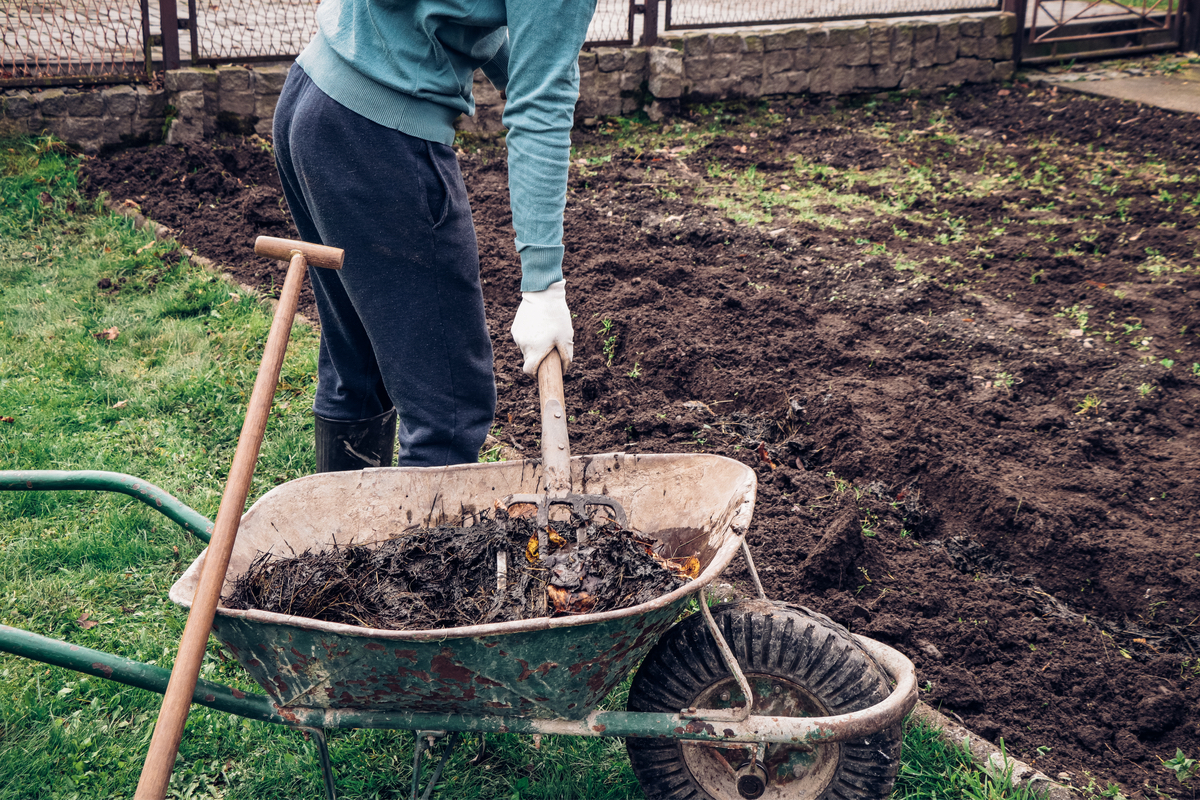
That being said, it’s always a good idea to apply fertilizer, such as compost, leaf mold or aged manure, when you prepare the soil for planting. And if you’ve planted in the fall, you can apply another top dressing of compost or bone meal in early spring. You can also use a slow-release balanced fertilizer (such as a 10-10-10 mix).
Be sure to mix the fertilizer into the soil and never place it directly in or around the bulb. If you’re applying it after the foliage has emerged, don’t allow the fertilizer to touch the leaves.
What should I do once my anemones are done blooming?
Most anemones will bloom for about a month to six weeks – again, whether that happens in the spring, summer or fall depends on what variety of anemone you’re growing. Once the blooms fade and the petals fall, you should allow the foliage to die in place. That’s when the plant’s corms are building up and storing energy to put into next year’s blooms.
The foliage of Anemone blanda (the Greecian anemone) dies back in early summer. The foliage of poppy anemones dies back in late summer or early fall. You need to keep watering this variety even after the blooms are gone, until the foliage withers. And of course, the fall-blooming Japanese anemone will die back in late fall.
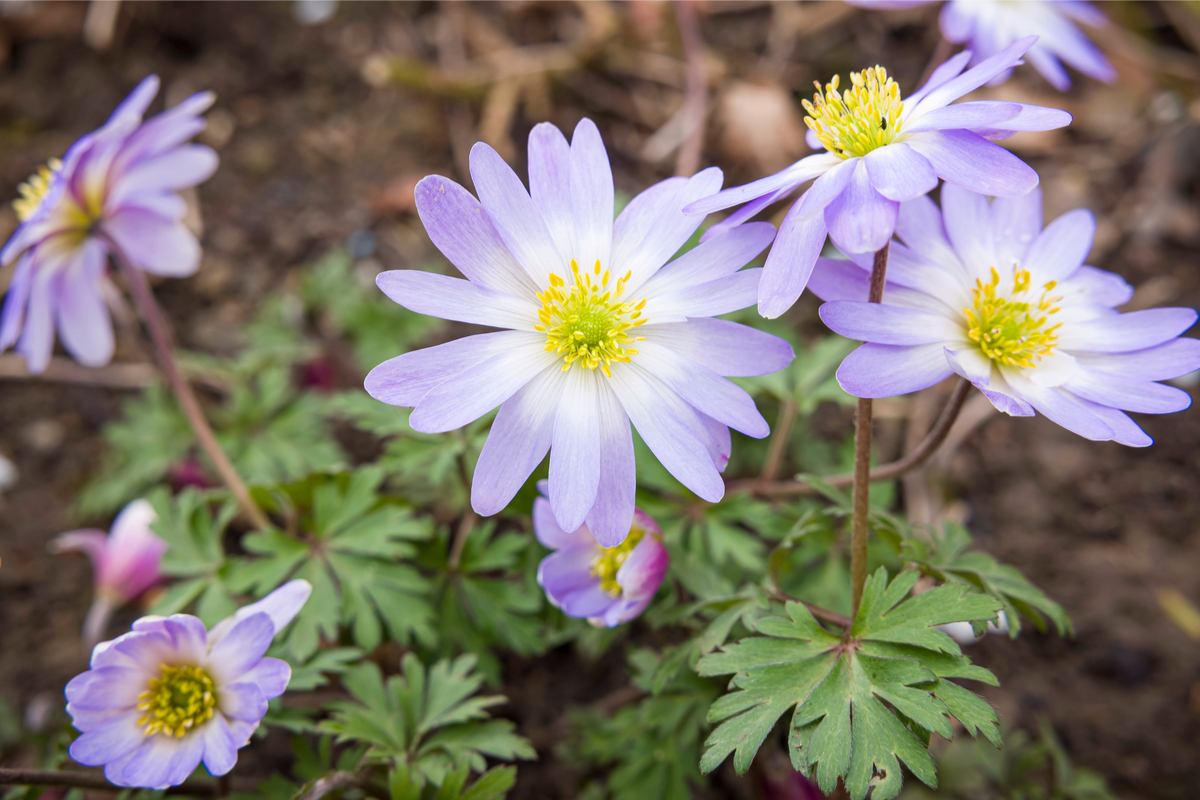
Whenever the foliage is gone, you can clean it up, but don’t disturb the corms in the ground just yet. Since there’ll be little sign of any anemone left, you may want to add a marker to know where to look for bulbs once the time comes to dig them up for storage.
And if you’re feeling extra organized, you can even add information such as the color of the flower and whether it’s a single-petal or double-petal bloom. I honestly don’t care about this part, since all the combos look beautiful to me. But some gardeners are very specific about their color schemes, and keeping tabs on what’s planted where helps a lot.
Can I overwinter anemones?
You’ve been enjoying your anemones during the spring and summer months, and you’d very much like to enjoy them throughout the next growing season. Luckily, most anemones aren’t hard to overwinter. Here’s how you can do it.
You can prune back Japanese anemones in the fall after the foliage turns brown and dies back. Leave the roots in the ground and mulch the plant to protect the roots from cold temperatures and frost. You can also prune the dead husks back the following spring in order to provide a habitat for pollinators and insects during winter.
Anemone blanda is usually hardy in USDA zones 5-9, so you can leave them in the garden to rebloom. Anemone coronaria is winter hardy in USDA zones 7-9.
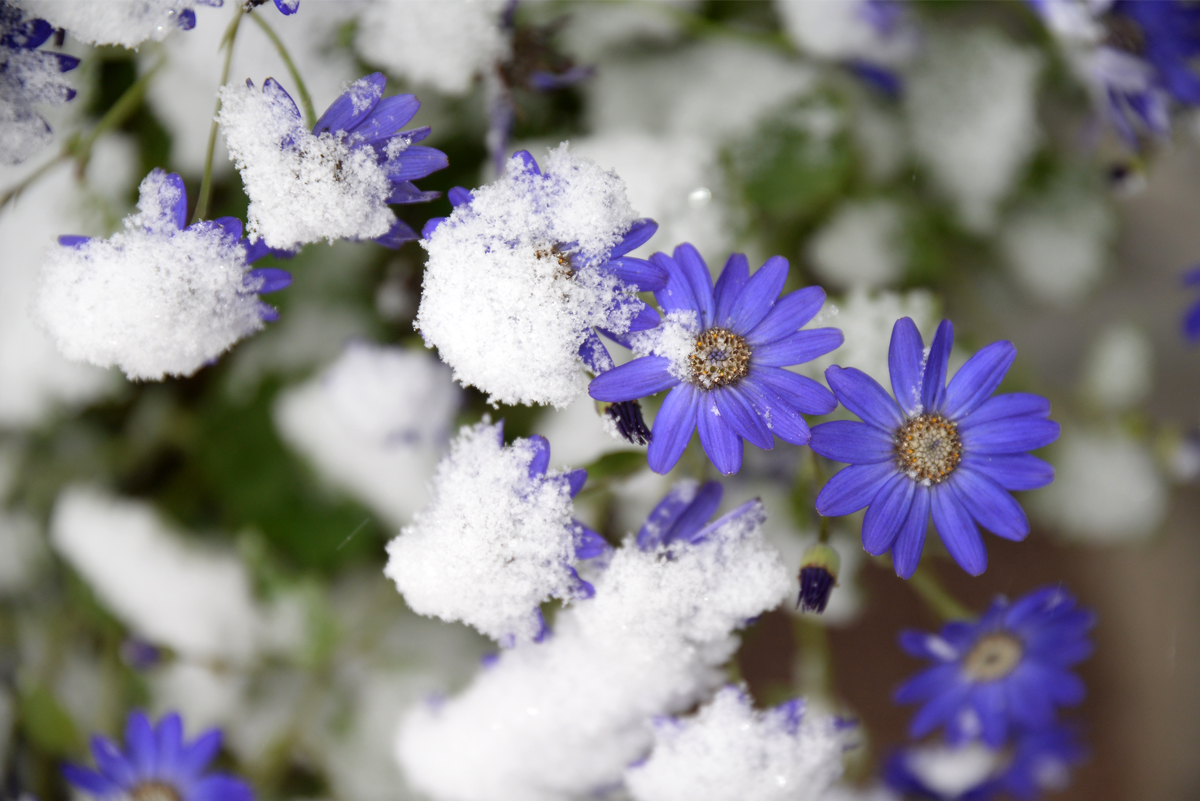
If you’re living in a colder climate (USDA zones 3-6) or just want to make sure your bulbs are stored safely throughout the winter months, here’s what you need to do in the fall.
Step 1: Let the foliage dry out completely, then gently remove it. For some varieties, you may have already done that earlier in the season.
Step 2: Dig out the corms and let them dry thoroughly in the sun or in a sheltered outdoor spot.
Step 3: Once the corms have dried, shake them vigorously to dislodge any dried-out dirt. You can gently use your fingers to clean up the remaining soil.
Step 4: Pack the corms into paper bags (do not use plastic packaging or bubble wrap). Store them in a cardboard box in a cool dry place that won’t freeze. You can store them in your shed or in the garage, as long as these places aren’t damp and the temperature doesn’t go below freezing in the winter. An optimal temperature would be 50-55F.
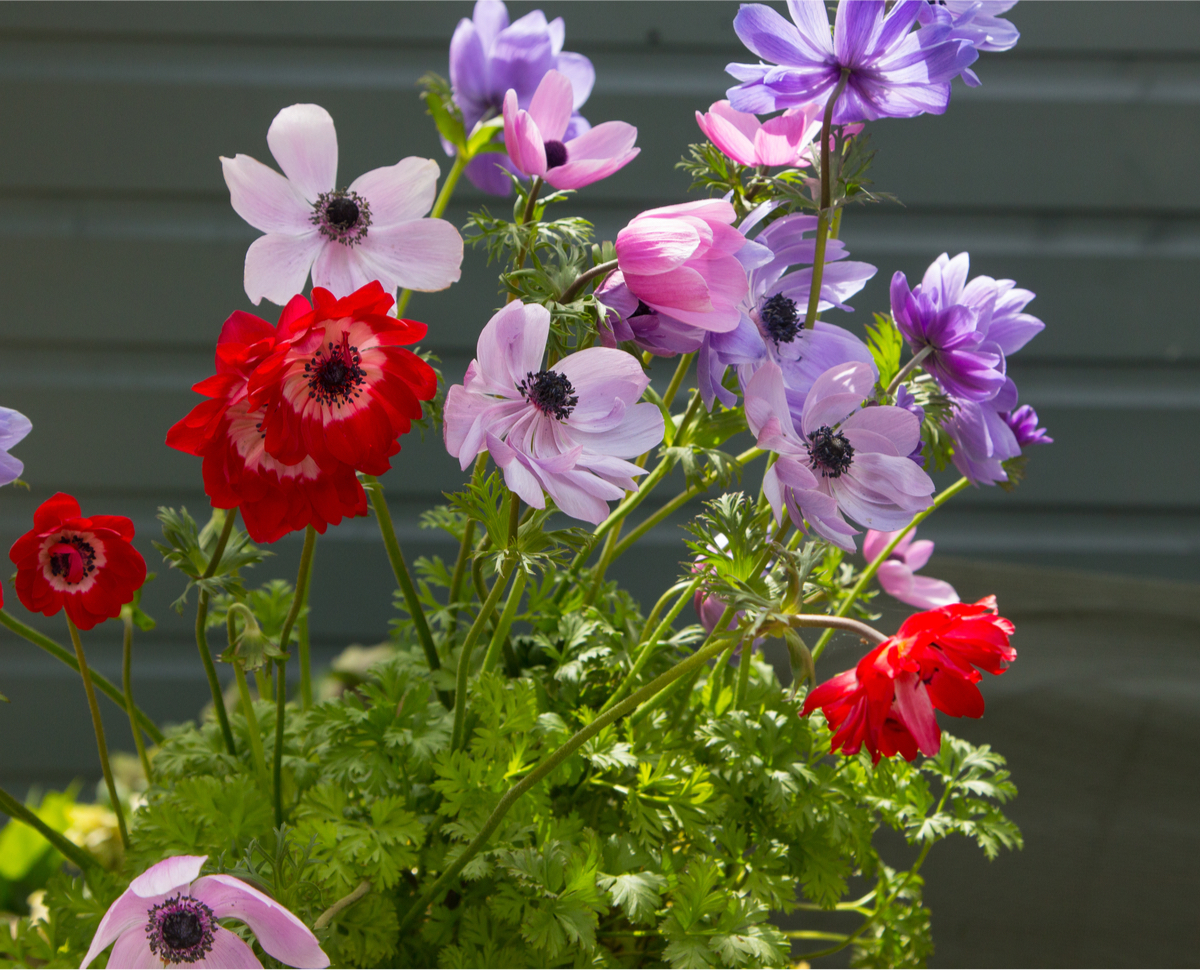
Step 5: Have a look at the corms every month to spot any early signs of mold or disease early. If you notice any signs that your corms aren’t storing well, immediately discard the ones affected to stop the spread.
Some gardeners in cold climates grow anemones as annuals (especially the Anemone coronaria variety) and just plant new corms each season. And some commercial growers rely on the shelter provided by polytunnels and greenhouses to overwinter their plants. It’s up to you to decide whether you want to bother storing the corms over the winter. I think anemones are definitely worth the extra effort.
Can I grow anemone from seeds?
My advice is not to bother with seed propagation due to a very slow germination rate. On top of that, it takes two years for a plant grown from seedlings to produce blooms, and when they do, the blooms don’t grow true to the parent plant.
If you really want to try propagating your anemones, you can do that via root division in early spring or fall (especially effective with fall-blooming varieties).
Other tips to enjoy your anemone season:
You can cut anemone flowers for indoor arrangements when the blooms are open. This will not hurt your plant.
Cut flowers can last up to two weeks in a vase, as long as you remember to change the water at least every other day.
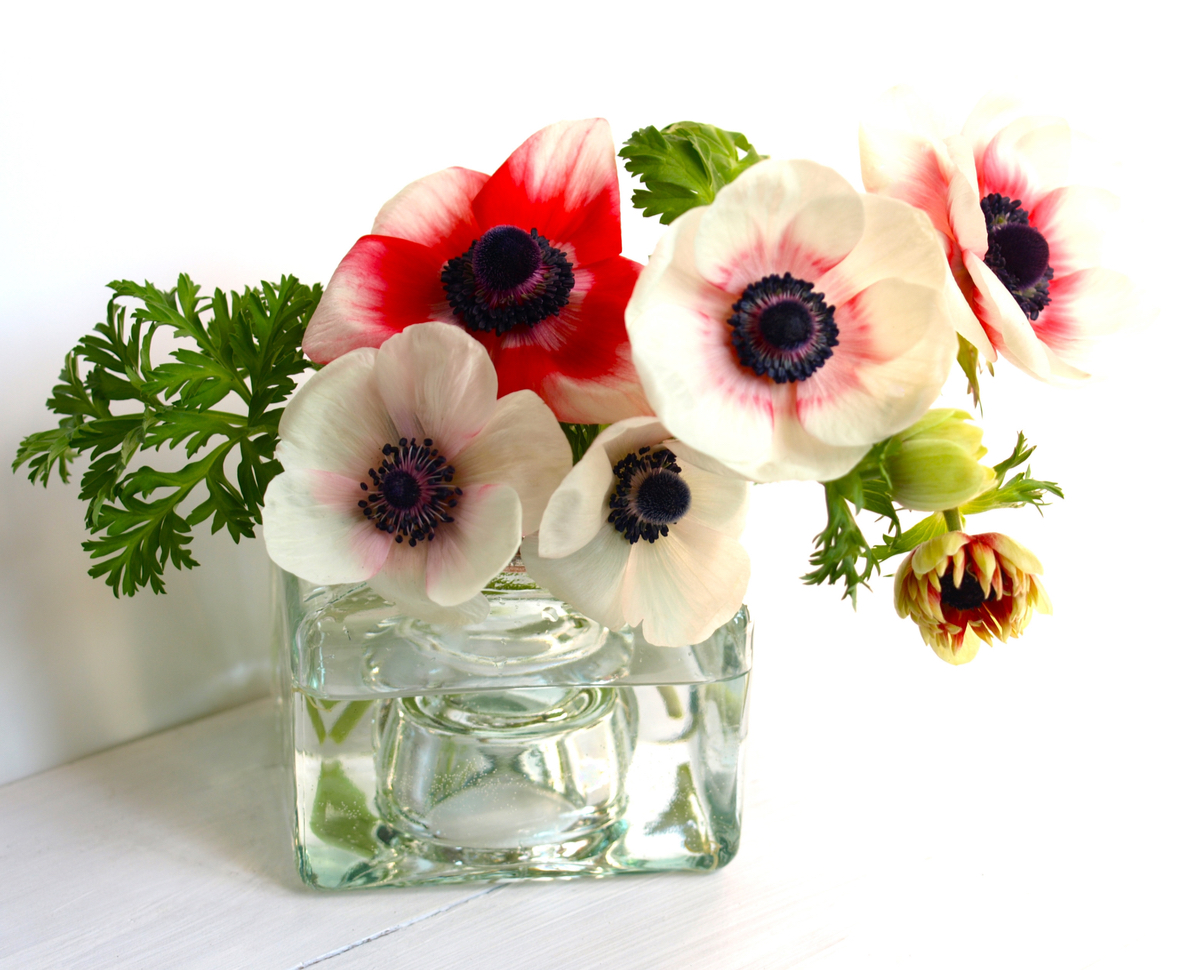
Anemones are not fragrant, so they can be combined with more fragrant flowers (such as lilies and hyacinths) without the fear of having competing fragrances.
You can mulch your anemones in order to keep the temperature and moisture in the soil even. Aged bark (not the dyed kind though) and shredded leaves make a beautiful canvas for anemone blooms to pop out of.
If you’re growing tall Japanese anemones, try to place them in a location that’s sheltered from extreme wind and direct sunlight. Generally, they don’t need staking, but if your variety grows too tall, it may need corralling with jute or twine.
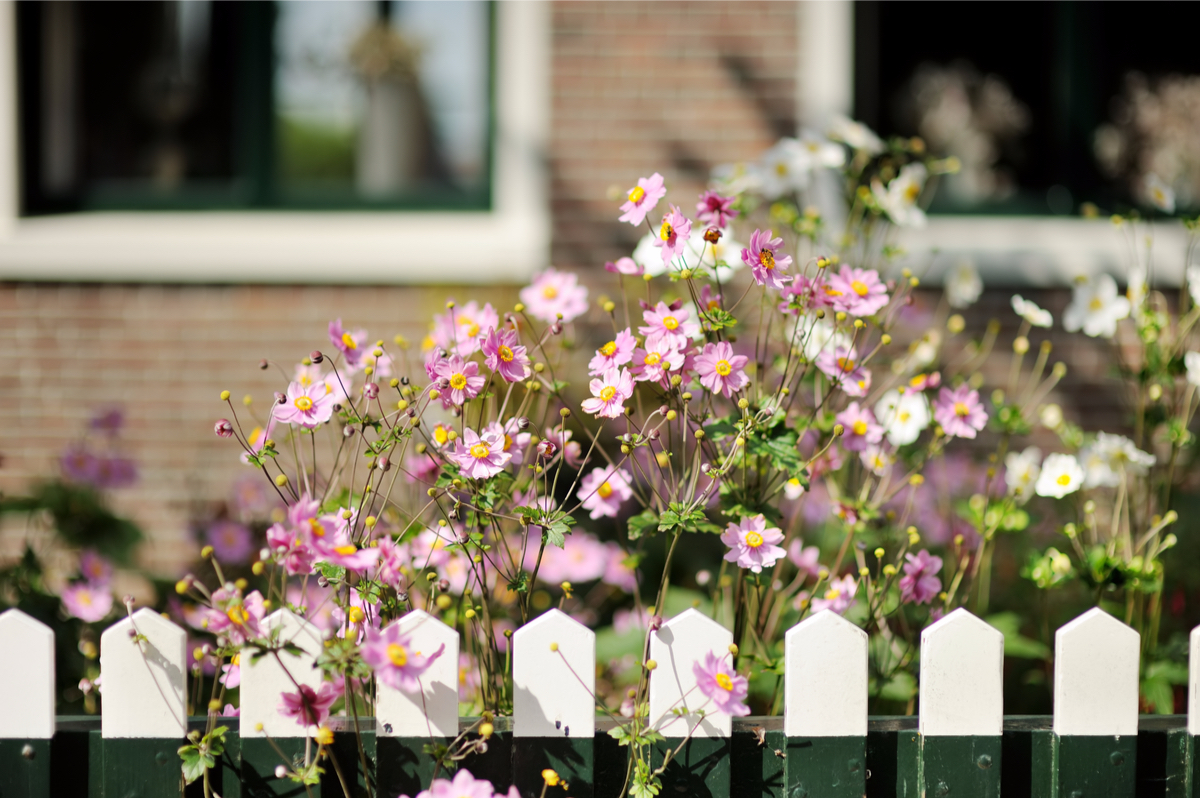
Aren’t anemones gorgeous? I think that once you give them a try in your garden, you’ll get hooked. I’m planning on adding new corms to my anemone collection every single year.
